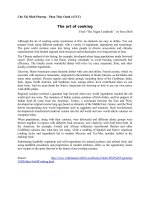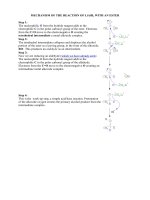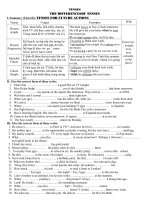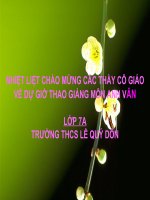The beauty of fashion
Bạn đang xem bản rút gọn của tài liệu. Xem và tải ngay bản đầy đủ của tài liệu tại đây (1.97 MB, 39 trang )
The
beauty
of Fashion
The what, why, who, where and when of fashion.
Javed Mohammed
A K2Vista Production
What is fashion?
It’s what
designers create
for a select
population which
later becomes a
trend.
Why People Wear
Clothes?
•
Traditionally
clothes primarily
worn for
protection from
the environment,
for privacy and to
enhance beauty.
Why People Wear
Clothes?
Why
Clothing?
Physical Needs
•
Protection
•
safety
Psychological
Needs
•
Identity
•
Adornment
•
Cultural
identity
Social
Needs
•
Affiliation
/ fitting in
•
standards
Good fashion= Good
design
A combination of:
•
Line
•
Shape
•
Color
•
Texture
•
Pattern
Cycle of fashion lasted
decades
•
In early traditional
cultures, styling of
clothes did not
change or if it
changed stayed
for a long period.
Travel changed this
•
From Baghdad to
Moorish Spain;
Turkey to Middle
East and Central
Asia.
Paris: Where fashion
began
•
Paris, France from
1600s became
center of fashion,
where French
royalty and affluent
used designers to
outfit them.
Haute culture
•
Started after the French
Revolution (1789), haute
couture design firms grew.
French for “Fine Tailoring”
High-fashion, individually
designed, original, handmade
garments for the elite, $2K-
$40K.
A little history
1900s-1950s
•
US magazine Vogue in 1909 helped spread the
word in fashion
•
Manufactured fabrics, included nylon and rayon
•
Looser fitting, functional clothes, especially for
workforce
•
Long hair, Long hemlines, corsets, hats
1920s and chanel
•
Chanel liberated women
from "corseted silhouette"
and popularized the
acceptance of a sportive,
casual chic as the
feminine standard.
chanel
•
Her influence
went beyond
clothing into
jewelry,
handbags, and
Chanel No. 5
fragrance.
Women’s liberation
•
Shorter hair, disbandoned Victorian era clothes
•
Shorter skirts
•
Nylon (cheaper hosiery)
•
Corsets abandoned
•
Alternating long hem lines, narrow shoulders and tightly
fitted bodices with long, full, or narrow skirts.
1960’s
•
Hippie style – liberal
fashion with influence
from the east, using
bright colors, peasant
embroidery,
cheesecloth, and safari
jackets.
60’s continued
•
Clothes came in brighter colors
•
In 1966, Mary Quant came up with the idea
of the miniskirt
•
Pants become commonplace for women
•
The mod and hippie subcultures emerged
•
Twiggy become a fashion icon
1970’s
•
Influence of disco,
punk, and feminist
movement included:
torn clothing, pant
suits for women, and
influence of white,
neon and after-glow.
1980’s
•
Business casual with the power
look and health conscious.
High price not linked to high
fashion and more use of easy to
care synthetic fibers.
Rebellious, colorful, and crazy.
1990’s
•
In US dress-down leads
the way to informality,
comfort and athletic look
override business attire.
Grunge – a style started
by youth culture. Messy,
uncombed, not too much
effort.
2000’s
•
Free-spirited:
Bohemian Chic and
Hipster - mixed
different styles from
punk, grunge, hippie,
hipsters using large
sunglasses, flowing
skirts, boots and loose
jumpers.
Fashion terminology
Designer Label
•
A cross between
couture and mass
market eg Donna
Karan, Yves St
Laurent, Gucci.
Mass market
•
Affordable ready-to-
wear, off-the rack high
street fashion while
trying to keep the look
of Designer or Haute
Couture eg Old Navy,
Gap, Abercrombie and
Fitch, H&M.
4 Fashion capitals
Chic and stylish
Dior ,Chanel,
Yves Saint
Laurent
Casual elegance
Valentino, Milan Fair
Unorthodox clothes
Vivienne Westwood
Clean-cut & casual
Calvin
Klein, Ralph
Lauren
PARIS
MILAN LONDON
NEW YORK
A fashion year
•
Work a year in advance
•
2 seasons:
–
Spring/Summer (lightweight)
–
Autumn/Winter (heavier fabrics)
The brand
•
Every fashion hub and
then every fashion
house has an identity.
The collection has to
identify with the
brand/look and
complement each other.









